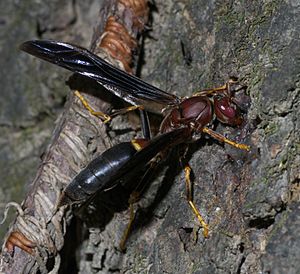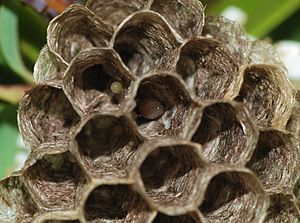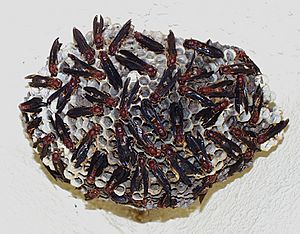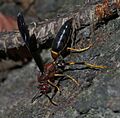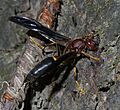Polistes annularis facts for kids
Quick facts for kids Polistes annularis |
|
|---|---|
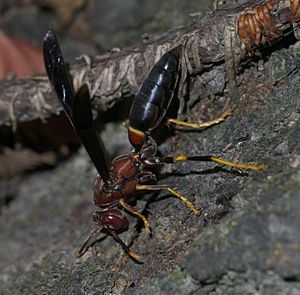 |
|
| Polistes annularis photographed in Oklahoma | |
| Scientific classification | |
| Synonyms | |
|
The Polistes annularis (P. annularis) is a type of paper wasp. You can find it all over the eastern part of the United States. This red paper wasp is known for being quite large and having cool red and black colors. People sometimes call it the ringed paper wasp or jack Spaniard wasp.
It builds its nests under rocky overhangs, usually near water. These spots help keep the nests out of direct sunlight. These wasps often build their nests close together in big groups. They eat nectar from flowers and other insects. Their main enemy is the ant, but birds also hunt them. Unlike some other wasps, P. annularis can handle cold weather pretty well. They even store honey before they go into a long winter sleep.
Contents
About Its Name and Family Tree
The first time anyone officially described P. annularis was in 1763. A famous scientist named Carl Linnaeus gave it the name Vespa annularis. Later, in 1804, another scientist, Johan Christian Fabricius, moved it to the Polistes group, which is where it still belongs today.
Within the Polistes group, P. annularis is part of a subgroup called Polistes (Aphanilopterus). This group has 52 species, including its relatives like the P. exclamans and P. bahamensis. Wasps in this subgroup have a thin first part of their body and often have orange tips on their antennae.
The name Polistes probably comes from a Greek word meaning "founder of a city." This makes sense because these wasps build their own "cities" or nests. The second part of its name, annularis, comes from a Latin word meaning "ringed" or "ring-shaped." This refers to the yellow ring on its body.
What It Looks Like
P. annularis has a narrow first body segment and bright orange antennae. These features help identify it in the eastern United States, where it lives alongside similar wasps.
Its body is usually rust-red on the head and chest area. Its main body (abdomen) is mostly black with a single, bright yellow ring at the end of the first segment. The colors can be a bit different depending on where the wasp lives. In the northern areas, the chest has rust-red marks on a mostly black background. In the southern areas, the chest is mostly rust-red with black marks. Their legs can also be black or rust-red.
Female wasps have front wings that are about 18.5 to 23.5 millimeters long. Males have slightly shorter wings, about 17.5 to 19.5 millimeters long.
It can be tricky to tell male and female P. annularis apart just by their color, because both sexes have red faces. Instead, you need to look at their body parts. Females have 12 segments on their antennae and 6 segments on their abdomen. Males have 13 antennal segments and 7 abdominal segments.
Where It Lives and Builds Nests
P. annularis lives across the eastern United States, from New York down to Florida, and west to states like South Dakota and Texas.
These wasps build their nests on tree branches, shrubs, and sometimes on buildings. They are also known to build many nests close together in large groups, called aggregations. They prefer to build under rocky overhangs that block sunlight most of the day. These spots are usually very close to water, like rivers. The availability of these overhangs is important for where they can build.
Their nests are much bigger than those of other Polistes wasps, often having around 500 cells. They are wide, not long and thin. The nests are made of paper, with open cells that you can see.
Life Cycle
In the spring, female wasps that have mated (called foundresses) come out of their winter hiding spots. They usually go back to the same area where they were born the year before. They start building new paper nests, often just a few feet from their old ones, but they usually don't reuse the old cells.
A group of foundresses might build a single nest together. This group usually has about five foundresses, but it can be anywhere from one to 22. One foundress becomes the "queen" or dominant one, and she lays most of the eggs. The other foundresses help build the nest. They use plant fibers mixed with their spit to make a papery pulp, which they shape into cells.
The nest hangs from the overhang by a stalk-like part called a pedicel. This pedicel is made of strong materials from the wasp's spit, similar to silk. It helps hold the nest up high, keeping many predators away.
The other foundresses also go out to find food, bringing back pieces of caterpillars for the baby wasps (larvae). They also help protect the nest. Even though there's a queen, the other wasps can still lay eggs and find food for themselves. At night and in the early morning, all the female wasps are on the nest.
The first group of baby wasps that grow up in the spring are mostly female workers who don't reproduce. Later in the summer, new female wasps that can reproduce, and then male wasps, are born. A few days after the males appear, they leave the nest to find mates. If all the original foundresses die or leave, a worker wasp can sometimes take over as queen.
From mid-July to mid-October, P. annularis nests stop producing new babies.
As autumn arrives and it gets colder, the worker wasps die off. The female wasps that can reproduce get ready for winter. They collect and store nectar in the open cells of the nest, which turns into a type of honey. By winter, these reproductive females leave the nest to hibernate (sleep through winter). They hide in safe spots like cracks in cliff walls. On warmer winter days, they might fly back to the nest to eat their stored honey. This helps them survive the cold. In early January, males and females start mating in their winter shelters. In the spring, the foundresses, often still with their nestmates from the previous year, start the whole cycle again.
Changes in the Life Cycle
The life cycle of P. annularis can change a little each year depending on the weather and other things in the environment. For example, if the original queen dies, a worker wasp might take over as the new queen. However, this can sometimes lead to the nest stopping new baby production earlier. Also, if there's a drought and less food, the wasps might stop raising babies sooner.
Foundresses that start a nest alone often have more babies than those who are part of a group with other foundresses. If a nest is destroyed, a foundress might join another nest, especially if the wasps there are from her original birth nest.
Behavior
What It Eats
P. annularis mostly hunts in wooded areas. They primarily eat caterpillars from many different types of moths and butterflies. They might also hunt flies, moths, butterflies, and other insects. The queen wasp usually stays on the nest, so the non-reproductive worker wasps do most of the hunting for food. Only in very small nests with just two or three foundresses might the queen also need to hunt. Once the first group of workers grows up, they take over the job of finding food. About 20% of their food is prey, and the other 80% is liquid, like nectar.
Wasp Roles and Leadership
P. annularis is a "primitively eusocial" wasp. This means that all individual wasps can potentially reproduce, no matter their role in the colony. They have a "dominance hierarchy," which is like a pecking order. The colony sizes are usually small compared to yellowjackets, and there are more females than males. This pecking order happens because the wasps compete for limited resources.
Dominant female wasps might chew on or push other wasps to show their power. They also tend to "wag their tails" and check the nest cells more often than lower-ranked workers. When a wasp from another colony arrives, the wasps on the nest will use their antennae to check them out. Sometimes, this can lead to a fight. These behaviors show that there's a lot of competition among the females to reproduce.
The queens usually lay the most eggs, but sometimes they let other wasps lay eggs too. Queens are more active on larger and newer nests. Queens usually have much bigger and more developed ovaries (where eggs are made) than the other wasps.
The dominance of a wasp is often linked to its size, weight, and fat content. Wasps that are heavier and have more fat usually have more developed ovaries.
Foundress Groups
P. annularis often builds nests in groups, with an average of 3 to 5 foundresses, but sometimes as many as 28. Only a small number of queens build a nest completely alone. About three-quarters of foundresses become helpers to a queen in a group nest. The biggest groups of foundresses happen when females build a new nest right on top of their old birth nest.
The number of foundresses is important for how successful a colony is. On average, colonies have a 60% chance of producing workers and a 65% chance of producing reproductive wasps. However, nests with only one foundress have a much lower chance (20%) of surviving until workers appear. Nests with four or more foundresses have an 80% chance of success. It's a bit of a mystery why helper foundresses don't just leave to start their own nests, as they might have more success that way.
Over time, extra foundresses tend to leave or die off once the worker wasps appear. This is because foundresses compete for space and resources, and workers can do all the same jobs with less competition. Also, workers are more closely related to their sisters (the new wasps being born) than to their own potential offspring. This means they have less reason to lay their own eggs.
Recognizing Family and Conflicts
Unlike some other wasp species, P. annularis is not very good at recognizing how closely related they are to other workers. They don't seem to prefer building nests with their closest relatives from their original birth nest.
However, P. annularis wasps do have special chemicals on their bodies called hydrocarbons. These chemicals might help them recognize other wasps. For example, males have the same types of hydrocarbons as females, but in different amounts. The nest paper itself also contains fats that might help workers recognize their family members.
When a nest loses its queen, the remaining foundresses will fight for control. These fights can last for weeks, and during this time, no new nest building or egg laying happens. Eventually, a new queen takes over, often the next oldest foundress. After a new queen is established, the fighting usually stops. Even with these fights, the care for the baby wasps doesn't decrease.
Nest Grouping
P. annularis nests often form in crowded groups because there are only a few good spots to build. These spots need to be under overhangs that block sunlight, don't flood easily, and are near water. Because of this crowding, there can be competition between different colonies. Sometimes, a female from one colony might try to take over another colony's queen. This can lead to fights, or the original queen might be forced out.
Unlike some animals that benefit from being in the middle of a group (like a "selfish herd" protecting themselves from predators), P. annularis colonies in the center of a group actually face more competition than those on the edge.
Helping Each Other (Altruism)
Like many other social insects, P. annularis shows altruistic behavior, meaning they help others even if it costs them something. For example, even though worker wasps can become queens and have their own babies, they often lay very few eggs (less than 10% of what the queen lays). This greatly reduces the worker's own chances of having offspring, but it helps the queen have many more. Scientists are still trying to understand why and how this level of helping behavior continues in P. annularis.
Interactions with Other Species
Birds sometimes try to knock P. annularis nests down from their overhangs. Colonies that hang low to the ground can be attacked and eaten by raccoons. During warmer winter days, wasps returning to their nests for honey can be attacked by other wasps, including yellowjackets, and by mammals. However, Polistes wasps have learned to hide their nests from most mammals or put them in hard-to-reach places. They will attack any invading insects.
The main predators of P. annularis are ants. To protect the nest, the pedicel (the stalk holding the nest) contains special fats that make ants avoid it. The wasp is also sometimes attacked by other insects like the Elasmus polistis wasp and the Chalcoela iphitalis moth.
P. annularis defends itself and its nest by stinging. The venom from their sting contains a substance called antigen 5, which can cause allergic reactions in some people.
Images for kids


